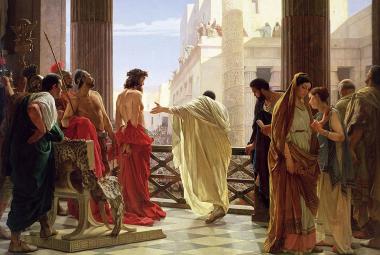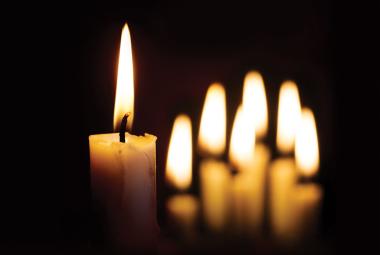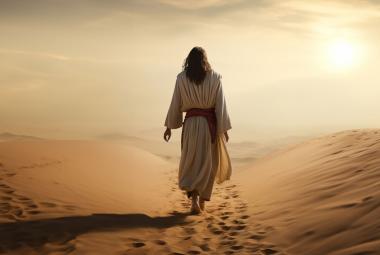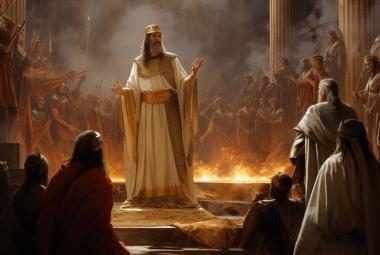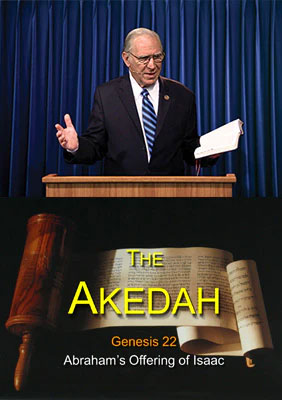As we prepare our hearts for Easter next month, I thought we’d review the famed incident of Abraham offering his son Isaac in Genesis chapter 22, called in Hebrew the Akedah. Let’s review this strange account.
And [God] said, Take now thy son, thine only son Isaac, whom thou lovest, and get thee into the land of Moriah; and offer him there for a burnt offering upon one of the mountains which I will tell thee of.
Genesis 22:2
Don’t let the familiarity of this story mask its bizarre implications. Why did God ask Abraham to sacrifice his son as an offering? This has to be one of the strangest episodes in the Old Testament.
We all know the story: Abraham takes Isaac, two young men and a donkey, and travels three days to Mount Moriah. Abraham leaves the donkey and the two young men at the base of the mount, and takes Isaac to the top where he prepares to offer him as a sacrifice. At the final moment, an angel interrupts the proceedings and a ram is substituted.
But what’s the real point of this famous event?
Some Observations
First of all, we need to recognize Abraham’s assumptions. He knew that Isaac would be resurrected if killed: God had promised Abraham that Isaac would have children.1 It was God’s problem, not Abraham’s. (Abraham had learned a lot about faith by the time he gets to chapter 22.)
Also, Abraham knew that he was acting out a prophecy! He named the location, “In the mount of the Lord it shall be seen.”2 With this in mind, let’s reexamine some of the details. As they leave the two young men at the base of the hill, Abraham indicates that they both will return.3
As Abraham and Isaac climb the hill, Isaac is carrying the wood on his back, and asks, “Where is the lamb?” Good question. Abraham answers, “God will provide (who?) himself a lamb…” We need to realize that 2,000 years later, another Father offered His Son on that very spot!
How long was Isaac “dead” to Abraham? He was, in traditional Jewish style, “dead” to Abraham as soon as the commandment came,4 and returned to “life” three days later! This is called, in Biblical parlance, a “type.” (We might use the more modern term, “model.”) Abraham is a “type” of the Father; Isaac, a “type” of the Son; the entire episode, an anticipation of the New Testament event. But there’s more...

The Topology of Mount Moriah
If we examine the topology of Mount Moriah, we find it is a ridge system between the Mount of Olives and Mount Zion. It is bordered by the Kidron Valley on the east, the Hinom Valley on the south, and the Tyropean Valley on the west.
If we approach the Mount as Abraham did, from Beersheva to the south, we begin at about 600 meters above sea level, and climb to its peak, about 777 meters above sea level.5
Many years later, David would purchase the threshing floor of Arunah where Solomon would eventually build the Temple.6 (A threshing floor was located where a prevailing wind would facilitate the separation of the grain from the chaff.) In this case, it was at about 741 meters above sea level, but just below the peak. (See map, right. Each line is 10 meters in elevation)
The Offering Site
The peak of the Mount is at a place just outside the city wall to the north. It’s a place you can still visit today, just above an Arab bus station outside the Damascus Gate. It is known as Golgotha.
Isn’t it fascinating that a group of Roman soldiers erected three crosses 2,000 years ago on the very spot that Abraham offered his son so many years earlier?
The Missing Person
In Genesis 22, after the offering is completed, verse 19 lists the people that went home:
So Abraham returned to his young men, and they rose up and went together to Beersheva; and Abraham dwelt at Beersheva.
Genesis 22:19
The two young men were still waiting at the bottom of the hill with the donkey. So they all went home. There’s one small problem: Where’s Isaac?
Obviously, we all assume that he joined them on the return trip, and I’m sure he did. But notice that he is not mentioned. In fact, Isaac is “edited out of the record” from the time that he is offered, until he is united with his bride at the well of LaHai-Roi (“The well of the Living Water”) two chapters later. Just as His Bride now awaits being united with her “absent” Lord!
The New Testament is in the Old Testament concealed; the Old Testament is in the New Testament revealed.
Isn’t God great? Isn’t it amazing how far He has gone to show His love for us? A love story written in blood, on a wooden cross 2,000 years ago. This was all arranged so that you and I might have life with Him throughout eternity. Wow. Where’s “Isaac” in your life?
Notes:
- Genesis 17:19.
- Genesis 22:14.
- Genesis 22:5.
- Hebrews 11:17-19.
- Abraham offered Isaac at the top; there was a settlement at the base (Gen 14:18).
- 1 Chronicles 21:18-26

